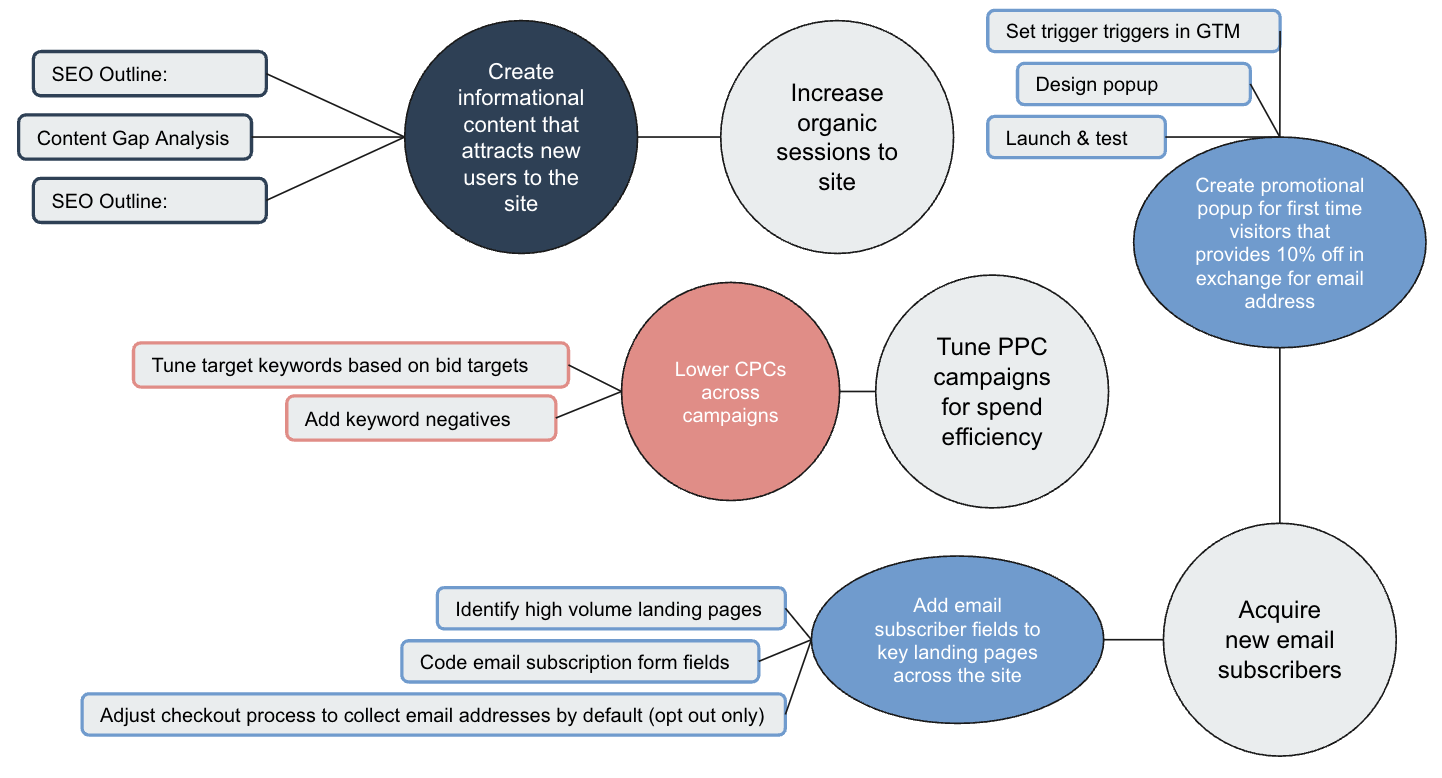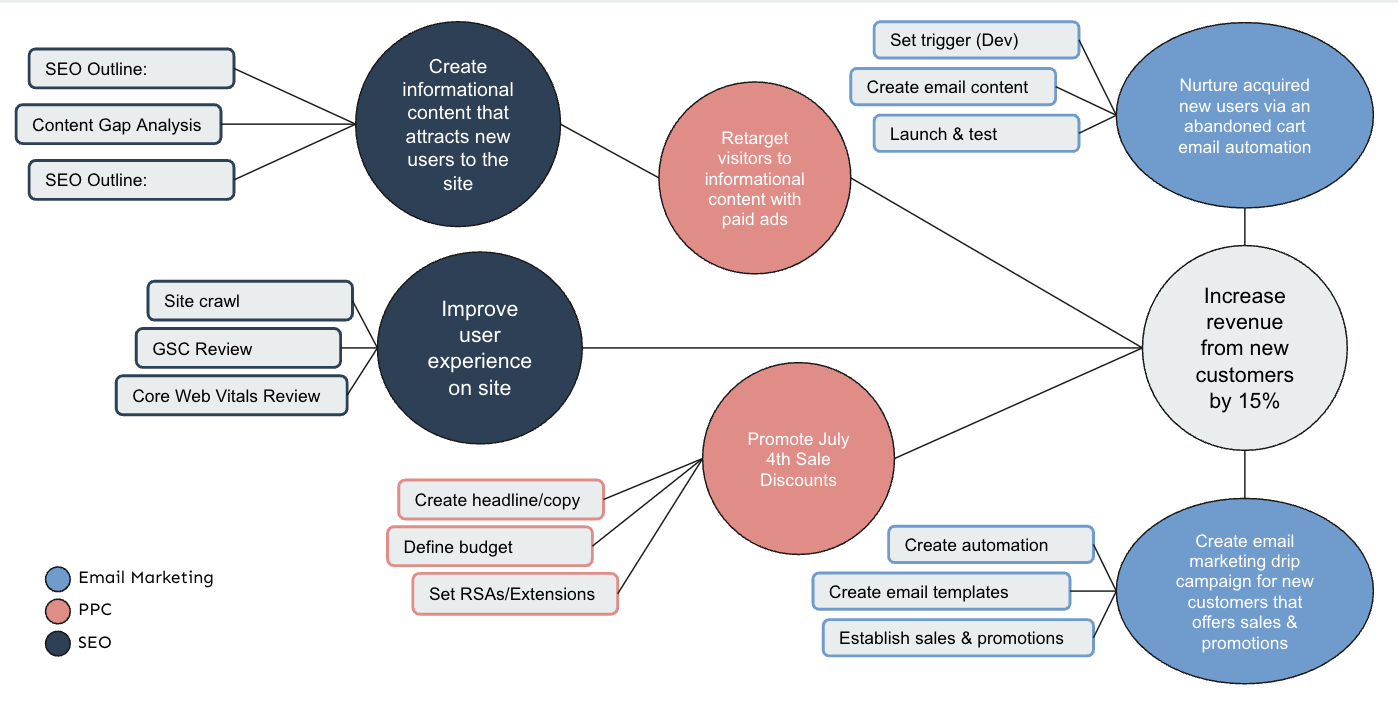Table of Contents
Today’s economic environment changes constantly. Economies fluctuate, businesses adjust their position, and technology changes the way in which we engage in our work on every level. As digital marketers, we understand that marketing plays a critical role in maintaining and growing a business in both times of stability and times of change. To convince other stakeholders of this as well, we need to shift our approach to project management in digital marketing and align our strategies directly with measurable, monetary business outcomes.
Related Articles:
The Role of Project Managers in Bridging the Gap
In a digital marketing agency, project teams consist of clients, digital marketing experts, and project managers. As project managers, we have a unique role in bridging the gap between the expertise of our team members and the impact of their efforts on business outcomes. Although we may not be experts in every vertical, we understand the tools available in our digital marketing toolbox and how they should work together to drive results. This broader perspective allows us to effectively align our marketing strategies with business goals, advocate for our clients, and explain the impact of our efforts in a way that speaks directly to their objectives.
Shifting Strategy Requires Reevaluating Reporting Methods in Digital Marketing
To achieve effective project management in digital marketing, it is essential to focus on the right measures of success. Traditional reporting methods often center around individual key performance indicators (KPIs) unique to each marketing channel, such as organic sessions for SEO or click-through rates for email marketing.
However, this approach fails to connect these metrics to business outcomes.
Organic sessions don’t save businesses.
Email click-through rates don’t generate revenue unless they convert subscribers.
Therefore, when businesses face economic challenges, or, the economy starts to shift, or endless talks of impending recessions make everyone nervous, they tend to cut marketing investments based on the perceived lack of correlation between metrics and tangible results. To overcome this disconnect, we must plan our strategies with business outcomes as the primary focus.
Prioritizing Business Outcomes in Digital Marketing Strategy
To align digital marketing strategies with business goals, we need to understand our clients’ measurable, monetary objectives. This includes revenue targets, lead generation goals, return on investment (ROI) expectations, and other key performance indicators. By establishing a clear understanding of these goals, we can structure our project strategies around them. This business-first approach enables us to demonstrate how our work directly contributes to the client’s bottom line and positions marketing as a mission-critical investment.
Shifting Perspectives: Approaching Digital Marketing Strategy through the Lens of Business Outcomes
Traditional project strategies often prioritize individual channel metrics, resulting in siloed efforts. To overcome this, we need to create synergies across verticals and align everyone’s efforts toward a single, meaningful business outcome. By integrating channels and strategies, we can create a cohesive approach that drives tangible results for our clients. This shift in perspective requires thinking beyond siloed metrics and considering how each task and initiative contributes directly to the central business goal.
Below are two examples of how a team may design a digital marketing strategy. The first example focuses on traditional marketing metrics:

In this example, it’s clear how the tasks and initiatives set will accomplish these goals. However, it’s unclear how these initiatives and KPIs will directly impact business outcomes. A business executive reviewing this strategy may easily think to themselves, “I can forgo organic sessions and new email subscribers. I need to focus on revenue.”
Marketing strategies planned through the lens of business outcomes, on the other hand, build synergies across verticals and invest everyone’s efforts into achieving a single, meaningful, monetary outcome. These strategies may look something like this:

In this example, it’s immediately clear how marketing functions contribute directly to a client’s bottom line, thereby making it more likely that a client will retain these verticals even through challenging times.
Approaching project strategy in this way requires a new way of thinking about our work with clients, the strengths and weaknesses of the marketing channels we manage, and how we measure success. Below are some steps for moving your projects in this direction:
Understand your client
Understanding your client is key to driving business outcomes in digital marketing. Do you clearly understand your client’s measurable, monetary business goals? If it’s revenue, how much? If it’s leads, how many? By when? For what ROI? What counts as a qualified lead? Or are we more focused on MQLs? Within what level of the marketing funnel are there gaps? The answers to these kinds of questions form the foundation for planning your project strategy.
Evaluate the tools in your toolbox
Are they the right tools for the job? SEO may be effective in building brand awareness, but it’s not the right tool for driving revenue within a short period of time. If revenue is your client’s goal and the only tool you have in the toolbox is SEO, it’s time to talk to your client about adjusting their scope of work to add tools like PPC which may be better suited to achieve their goals. If that’s not an option, set clear and quantifiable expectations and be transparent with your client about what is achievable within the given timeframe and budget.
Establish the measure of success
Once you have a clear understanding of your client’s desired business outcomes, you need to set the central, business-driven goal for your team. Structure internal strategy meetings around this central goal. Ask questions that encourage vertical experts to think about how they can contribute to business outcomes across channels. Map it out if you need to. Get a bit messy in the middle. Reframing how you think about project strategy isn’t linear. It requires some critical brainstorming.
Defend that measure of success fiercely
Transitioning to this new approach may face resistance from team members accustomed to traditional reporting methods. It is essential to defend the measure of success that aligns with the client’s business outcomes. Continuously evaluate tasks and initiatives to ensure they contribute directly to the central goal. Encourage open discussions and push for explanations to ensure alignment between strategy and desired results. Although this shift may be challenging at first, it sets the project on a path to success and enhances our ability to explain the impact of our efforts to clients.
Let the experts be experts
Rallying your team around a central goal does NOT mean that you are suddenly a vertical expert. As project managers, our role is to guide the team and evaluate strategies through a client lens. Let the digital marketing experts on your team provide insights and recommendations based on their expertise. You know where you all need to go, allow your team to tell you how to get there.
Assess performance against the central goal
Assess performance against the central business goal and communicate the impact of marketing efforts in a way that aligns with the client’s objectives. Focus on relevant metrics that contribute to the narrative of success and highlight how each vertical worked together to achieve results. For example, rather than report on the organic sessions a particular page earned, consider the rate at which visitors to that page flowed to other high-value pages on the site. Rather than assess conversions by channel, consider direct conversions AND assisted conversions to tell a better story of how each vertical worked together to drive results.
The Benefits of Aligning Digital Marketing Strategy with Business Outcomes
When clients can directly see the impact that marketing has on their bottom line, they are more likely to see marketing as an essential component of their business. By aligning project strategy with business goals, we not only achieve better outcomes for clients but also use everyone’s time more efficiently. This alignment optimizes resources, improves ROI, and retains clients.
In conclusion, as project managers, it is our responsibility to bridge the gap between marketing efforts and business outcomes. By demonstrating the direct impact of marketing on the client’s bottom line, we solidify the importance of marketing as an essential component of their overall business strategy.
Search News Straight To Your Inbox
*Required
Join thousands of marketers to get the best search news in under 5 minutes. Get resources, tips and more with The Splash newsletter: